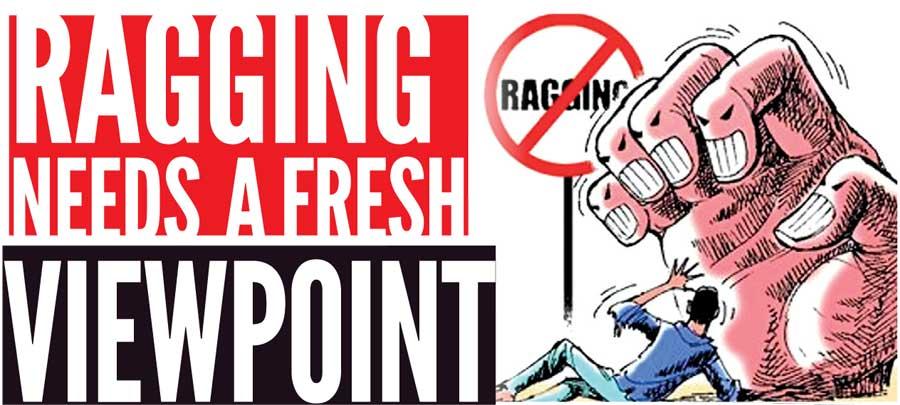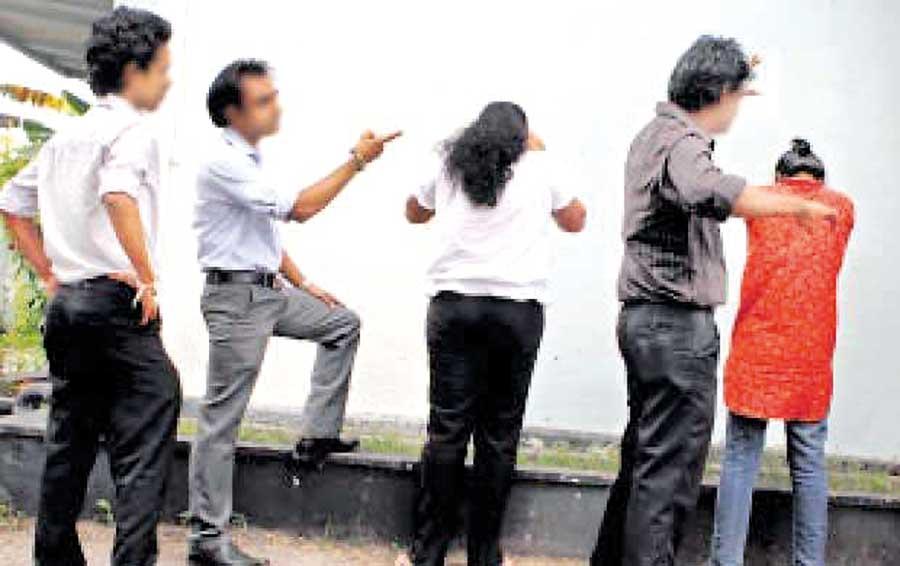Reply To:
Name - Reply Comment

Only thing one can be sure of is that ragging has become more physically barbaric and psychologically violent
Rituals of ragging can be gruesome, sometimes deadly. Since 1975, there has been 16 ragging-related deaths and according to UGC, over 2000 students drop out every year in order to stay away from ragging. The experiences of ragging-exposed students are not only brutal and horrific but also expose the existence of such barbaric acts within our universities.
Recently, the UGC along with Ministry of Higher Education, UNICEF and other universities, conducted a study titled “Ragging, Sexual and Gender based violence in Sri Lankan University system.” They obtained responses from 15000 and 1550 staff members. The study revealed that between 44-55 % of students report that they are being ragged while 28% report sexual or similar harassment. They also found out that ragging happens in all faculties and was not restricted to one campus. 
Is ragging increasing or decreasing? No one can give an absolute answer because there is no corresponding research to base the answer. Only thing one can be sure of is that it has become more physically barbaric and psychologically violent. In many ways, ragging has evolved for worse over the course of the 20th and 21st centuries.
Another question which pops up is why the practice of ragging persists right throughout the years. Seniors maintain ragging provides value to the group experience. They believe that it facilitates liking for the campus and builds bonds between those being ragged and the doers. Seniors regard it as a sub-culture tradition, one worthy of continuing.
The generally accepted theory, however, is different. It says ragging is carried out as a display of power dynamics, as well as a flattening of the hierarchy. The reasoning is that whatever the freshers are undergoing, the seniors before them have experienced the same. So, members in power, usually based on seniority, continue the tradition. And thus, the cycle continues. The difference is each year it becomes more and more violent. It has now advanced to a barbaric point where torture chambers are also introduced to the event.
Talking about the brutal physical acts of ragging, Prof. Chandrika Jayasinghe, Professor of Medicine, Teaching Hospital, Peradeniya, commented recently that such acts happen due to the greed to exert power. It combines with deranged mindsets due to not receiving love at their own homes and being harassed when they were young. She added, “Inferiority complexes, low self-esteem, general rage against the human race and derivation of sadistic sexual pleasures are also reasons behind these kinds of acts.”
However, what most people do not comprehend is the psychological consequence of ragging. Prof. Jayasinghe lists a few of them: stress, post-traumatic stress, anxiety, phobias and long-standing depression, Haemolysis (destruction of red blood cells), Rhabdomyolysis (destruction of muscle cells), renal failure, panic attacks and trauma. In some circumstances, the depression may become so great that the victim commits suicide.
Now coming up to the most important issue – how do we curtail ragging in our universities? Hundreds of solutions have been offered by writers and professionals in the recent past. But it is worth taking another fresh look in a different perspective.
First, universities should provide basic, mandatory anti-ragging training to all incoming freshmen. The training must be designed to just provide “some” information that washes over students. Rather, universities should educate them using effective teaching and learning methods. Moreover, students should be taught actual skills to address ragging, from bystander intervention to reducing one’s own biases.
Second, universities should provide their front-line staff with the tools needed to combat the issues. That would include training, whether on-campus or sending them to retreats or conferences
Third, universities should keep better data on ragging on their respective, campuses. It’ll be easier to get their heads around the issue if they can ascertain its prevalence, nature and scope in quantifiable ways.
Fourth, universities should allocate funds for faculty and divisions that seek to do research on the topic. One of the chief things that undermines our ability to understand ragging is that we have only limited ongoing research on the issue.
Fifth, we need honest continuing dialogue within campuses about race and gender. It is said that ragging manifests itself differently in campuses in unexplained ways. For example, according to the news media, some universities have far more reported violent ragging than others. In some universities, ragging is much more defined by alcohol use. In some, ragging seems to be much more perverse. We must get to the root of these issues and be able to analyse them.
Sixth, the laws must reflect what the social science dictates. In Sri Lanka, ragging is a criminal offence with rigorous punishment under the Ragging Act which was passed 21 years ago. The problem was that it was not implemented for a long time and as a result many students who were ragged did not come up and complain to the relevant authorities. The students are reluctant to step forward with their complaints because as soon as they do it, they are cornered in the university and assaulted.
It had turned up to a vicious cycle ultimately making the student a helpless victim. With that in mind, some analysts believe, anti-ragging statutes should have more bite than the current bark they tend to demonstrate. Some analysts argue that statutes must criminalize ragging at the felony level.
For 45 years we have been searching for an effective solution to the ragging problem. But we were not successful. One major reason for the failure was nobody took total accountability and responsibility. We cannot blame UGC. They were doing what they could, but the ultimate solution was beyond them.
It is not that the court’s concern was misplaced or that action does not need to be taken against perpetrators but merely that owning up has to precede fault-finding. The real problem starts from elsewhere. Isn’t the flurry of shocking incidents of ragging a sign of our growing insensitivity as a society? This is the question we have to answer.
And if the problem lies with the make-up of the society we live in, then its solution can hardly come from the weeding out of the manifestations of that problem and not treating its cause. The violent trait that seniors displayed in their behaviour to the freshers would inevitably get manifested every year unless treated professionally.
To make a start we have to go back to the school. A school is responsible for the overall intellectual and emotional maturity of its students and is also a place which gives its students human values. If our schooling system has failed to create sensitive human beings out of its class students, what is the purpose of the education it imparts? It is time for the Government to do some introspection and rethink where we have gone wrong.
The role of home, school and society cannot be neglected in the degradation of values. Definitely the life styles of parents leave deep impressions in the minds of children. Usually every child imitates virtues and vices of parents. Petty quarrels at home, frequent use of vulgar language in socio-economic backward families, bad habits of elders and poverty at home are responsible for deterioration of the system in our country.
School education too will play a vital role in moulding the future life of an individual. An upsurge in enrollment rate of students in educational institutions, lack of essential facilities and resources in schools, imbalance between teacher-student ratio, of mechanical book-learning, faulty education policies of the Government, worst type of political influences in schools, wrong attitude of teachers toward their profession and teaching, illegal and immoral home tuition classes from kindergarten level to higher education, highly ambitious parents with regard to performance and future job opportunities of their children, commercialisation of education, etc., are the source factors in decay of values in schools.
Modern Sri Lankan society too, has no set moral standards. Sense of responsibility and belongingness to a group are completely vanished. Mutual respect and consideration for others are disappearing. Social gatherings and group activities are organised without giving due weight to values. Communities are disunited. Community clashes are very common. Blind westernisation is still continued. Evil activities like drug usage are increasing day by day. The growing concern over the erosion of essential values and an increasing cynicism in society has brought to focus the need for readjustments in the curriculum in order to make education a forceful tool for the cultivation of social and moral values.
Therefore, ragging exists in Sri Lanka because the entire family, school and social system and the Government with its ministries and institutions have gone absolute corrupt.
In such a situation, the greatest point of intervention is the Government. It is the ultimate place the best decisions could be taken: who and how to address the source reasons of ragging, the amount of resources to be directed at the problem, what voices get heard or what voices need to be silenced, almost entirely boils down to the decisions of one small unit – the top political hierarchy. The buck stops there.
If they do not understand the problem, are not interested in addressing it, too insecure to acknowledge a lack of insight and look for legitimate help, the problem won’t get solved. Ultimately, across Government, we need to find good decision-makers - leaders - who are deeply committed to addressing
this issue.
The challenge is that given today’s warped and corrupted political structure and line-ups for leadership ascension, it may be virtually impossible to get such decision-makers in the foreseen future.
